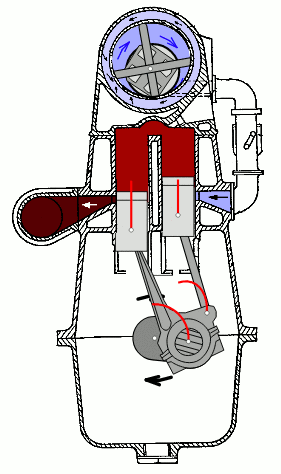Related Research Articles

Drag racing is a type of motor racing in which automobiles or motorcycles compete, usually two at a time, to be first to cross a set finish line. The race follows a short, straight course from a standing start over a measured distance, most commonly 1⁄4 mi, with a shorter, 1,000 ft distance becoming increasingly popular, as it has become the standard for Top Fuel dragsters and Funny Cars, where some major bracket races and other sanctioning bodies have adopted it as the standard. The 1⁄8 mi is also popular in some circles. Electronic timing and speed sensing systems have been used to record race results since the 1960s.

In engineering, the Miller cycle is a thermodynamic cycle used in a type of internal combustion engine. The Miller cycle was patented by Ralph Miller, an American engineer, U.S. patent 2,817,322 dated Dec 24, 1957. The engine may be two- or four-stroke and may be run on diesel fuel, gases, or dual fuel. It uses a supercharger or a turbocharger to offset the performance loss of the Atkinson cycle.

The Roots blower is a positive displacement lobe pump which operates by pumping a fluid with a pair of meshing lobes resembling a set of stretched gears. Fluid is trapped in pockets surrounding the lobes and carried from the intake side to the exhaust.
A centrifugal supercharger is a specialized type of supercharger that makes use of centrifugal force in order to increase the manifold air pressure, MAP. An increased MAP allows the engine to burn more fuel, which results in an increased power output. Centrifugal superchargers are generally attached to the front of the engine via a belt-drive or gear-drive from the engine's crankshaft.

Top Fuel is a type of drag racing whose dragsters are the quickest accelerating racing cars in the world and the fastest sanctioned category of drag racing, with the fastest competitors reaching speeds of 341.68 miles per hour (549.9 km/h) and finishing the 1,000 foot (304.8 m) runs in 3.62 seconds.

Allard Motor Company Limited was a London-based low-volume car manufacturer founded in 1945 by Sydney Allard in small premises in Clapham, south-west London. Car manufacture almost ceased within a decade. It produced approximately 1900 cars before it became insolvent and ceased trading in 1958. Before the war, Allard supplied some replicas of a Bugatti-tailed special of his own design from Adlards Motors in Putney.

English Racing Automobiles (ERA) was a British racing car manufacturer active from 1933 to 1954.

The Lancia Delta S4 is a Group B rally car manufactured by the Italian car company Lancia. The Delta S4 competed in the World Rally Championship in 1985 and 1986, until Group B class was disbanded and the cars were eventually banned from competition completely by European sanctioning body FIA. The car replaced, and was an evolution of, the 037. The S4 took full advantage of the Group B regulations, and featured a midship-mounted engine and all-wheel drive for superior traction on loose surfaces.

Sydney Herbert Allard was the founder of the Allard car company and a successful rally driver and hillclimb driver in cars of his own manufacture.
The 1930 24 Hours of Le Mans was the 8th Grand Prix of Endurance that took place at the Circuit de la Sarthe on 21 and 22 June 1930. It saw the first appearance of a German car and the first entry from female drivers.

The 1929 24 Hours of Le Mans was the 7th Grand Prix of Endurance that took place at the Circuit de la Sarthe on 15 and 16 June 1929.

In an internal combustion engine, a supercharger compresses the intake gas, forcing more air into the engine in order to produce more power for a given displacement.

The Powerplus is a design of supercharger that was used to boost the performance of car engines in the 1930s. It is a mechanically driven positive displacement pump, operating on the sliding-vane principle.

The 1924 Grand Prix season saw Grand Prix motor racing spread further across Europe and North America. In Italy a number of new open-road events were held. In France two new circuits were opened – at Montlhéry near Paris and Miramas near Marseille.

The Brighton Speed Trials, in full The Brighton National Speed Trials, is commonly held to be the oldest running motor race. The first race was held 19–22 July 1905 after Sir Harry Preston persuaded Brighton town council to tarmac the surface of the road adjacent to the beach between the Palace Pier and Black Rock to hold motor racing events. This stretch was renamed Madeira Drive in 1909 and the event is still held there, normally on the second Saturday of September each year. In 1936 Motor Sport described the event as: "undoubtedly the most important speed-trials on the British Calendar."
The Paxman Hi-Dyne engine was a form of experimental diesel engine developed for rail transport use by the British engine makers Paxman of Colchester. They used variable supercharging to give a constant power output across their speed range.

Kompressor is a marketing name for forced induction (supercharged) Mercedes-Benz engines. The term is not widely used by other motor manufacturers.

The Kawasaki Ninja H2 is a supercharged four-stroke supersport-class motorcycle in the Ninja sports bike series manufactured by Kawasaki, featuring a variable-speed centrifugal supercharger.
Altered is a former National Hot Rod Association (NHRA) drag racing class and a current drag racing chassis configuration that forms the basis of many classes of NHRA Competition Eliminator.

The Zoller supercharger was a vane-type supercharger created by Arnold Zoller (1882-1934) who had patents regarding supercharging engines before WW1. The Zoller supercharger was popular in the 1920s and 1930s.
References
- ↑ GB 411249,James Haydock (Jnr)&Christopher Shorrock,"Improvement in and relating to rotary blowers",published 7 Jun 1934
- 1 2 3 "Christopher Shorrock". Coventry Evening Telegraph. 5 September 1958. p. 10.
- ↑ "Centric Superchargers Ltd (in voluntary liquidation)". Lancashire Evening Post. 16 February 1939. p. 1.
- ↑ "Ferguson Buys Shorrock". Commercial Motor. 25 January 1952. p. 666.
- ↑ "In a Line or Two". Commercial Motor. 22 October 1954. p. 405.
- ↑ "Britain in the "Monte"". The Sphere. 7 February 1959. p. 36.
- ↑ "New Effort to Boost Supercharger Sales". Birmingham Daily Post. 12 July 1961. p. 16.
- ↑ "Allard Boost in Daventry". Coventry Evening Telegraph. 3 October 1973. p. 4.
- ↑ Smith, Philip Hubert (1954). Design and Tuning of Competition Engines. G.T. Foulis & Co. p. 271. ISBN 0837601401.
- ↑ "Supercharged Tractors for Mountain Farming". Coventry Evening Telegraph. 11 February 1958. p. 3.
- ↑ "A Five-Year Plan of Road Work". Lancashire Evening Post. 30 January 1935. p. 9.
- ↑ "A 1100cc Car Averages 186.5 mph". Illustrated Sporting and Dramatic News. 18 November 1938. p. 37.
- ↑ "Major Gardner breaks Light Car Records". Dundee Evening Telegraph. 31 May 1939. p. 8.
- ↑ "Moss does 246 in Roaring Raindrop". The People. 25 August 1957. p. 9.
- ↑ "Accent on Speed at Olympia". Birmingham Daily Post. 22 January 1964. p. 4.